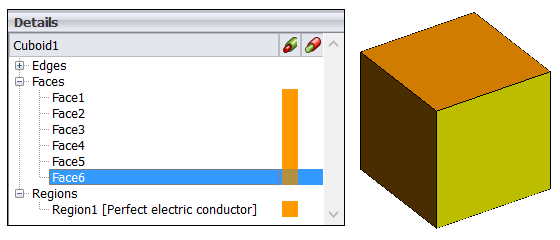Faces (Geometry)
Faces are individual surfaces of a part. By default, a face is set to perfect electric conductor (PEC).

Figure 1. Select a face in the 3D view to highlight the corresponding entry in the details tree. The converse is also true.
- Face medium
- Metallic (to model skin effect).
- Layered dielectric
- Impedance sheets (to represent metal surfaces in cases where only the surface impedance per unit area is known).
- Characterised surface
- Coating (layered dielectric)
- Dielectric sheet
- Local mesh size
- Solution methods
- Basis functions (local setting)
When an operation results in a face being split into multiple faces, both the resulting faces inherit the properties of the parent.
For operations where multiple faces need to be merged but have conflicting properties, an assumption will be made and the face will be marked suspect to indicate that the settings need to be reviewed.